Dude! Take Your Turn!
A Gaming Life
New to Me – March 2024

Aloha! (Saying this for my friend who’s out on a cruise, even though she’s not technically going to Hawaii but somewhere just as warm).
You may be wondering.
“Dave, why are you wearing socks with sandals?”
I would say that you should just keep your damned opinions to yourself, you young whippersnapper.
You may also be wondering why it’s been almost 2 months since a “New to Me Games” post.
That’s because I played nothing new in February!
I did note that…were you paying attention?
Anyway, with a convention in March, I knew that things would take a drastic change for the better this month.
Lots of games to talk about!

While it wasn’t as bad as OrcaCon in regards to making this post super-long, it was still a great month for them.
So, without further ado (all of my ado was used to seal the joints of a Viking warship anyway), let’s begin!
Shipwrights of the North Sea – Redux (2024 – Garphill Games/Renegade Game Studios) – 3 plays
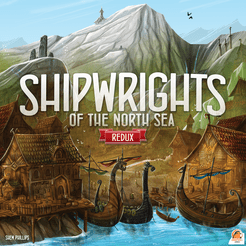
Designer: Shem Phillips
Artist: Mihajlo Dimitrievski
Players: 1-5
Shipwrights of the North Sea – Redux is a complete revamp of the original Shipwrights of the North Sea game, one of the first games by Garphill Games (if not the first).
Rather than me typing more, though, how about just reading my review?
Kanban: Driver’s Edition (2014 – Stronghold Games) – 2 plays (kind of)

Designer: Vital Lacerda
Artist: Naomi Robinson, Vital Lacerda, William Bricker
Players: 2-4
This is the first Terminal City Tabletop Convention game that I’m going to talk about.
There are a few!
This is a Vital Lacerda game that I’ve been wanting to play for quite a while.
Not just because it’s in the Top 100 on Boardgame Geek, but because I tried playing it on Boitjeaux.net a couple of times and I really wanted to learn it better and on the table.
Of course the Driver’s Edition is not in the Top 100 (the EV edition is), but I still got it played!
Being a Lacerda game, it’s complicated and you have to really be efficient to pick up the points you need.
This is a game about manufacturing cars.
How corporate can you get?
The only thing missing is the union label.

The board has all of the departments involved in building cars. You can get car designs, manufacture the parts required for them, use those parts to send cars off the assembly line, or either take a car for your garage or upgrade a car design.
And, of course, there are not only regular meetings but also an HR representative who is monitoring your progress and penalizing you if you’re not doing a good job.
Sandra is a big part of this game!
Each turn, you’re going to be placing your worker in one of the departments (that is different from the one you are currently in), placing it on a space that is not already occupied by somebody else.

So you have to plan your moves. Do you have a blueprint to take a car? Or a blueprint and part to upgrade the car?
If you don’t, then you probably shouldn’t put your worker in the first department.
What’s important in the game is time and shifts. Each space where your worker goes will grant you a number of shifts in that area, usually either 2 or 3.
You will be accumulating extra shifts through various processes, which not only helps you against Sandra (you only lose points when Sandra penalizes you equal to 5 minus the extra shifts you’ve accumulated) but also gives you extra shifts to spend in case you really need to do something.
In each department, you can do a number of things, either the actions based on the department (like gaining parts in the Parts department) or training to become better at it.

When you become certified, you get an extra benefit, and getting really certified (i.e. at the top of the training track) may get you an extra seat at the table during meetings!
It may also get you a bonus.
Inevitably, there will be a meeting where you have to tout your successes.

If you’re not able to do that, because you haven’t had any successes, then you’re shit out of luck!
When Sandra returns to her desk (she moves to the right on the action space track, to the next available space in a different department, until she returns to her desk), she will trigger weekly scoring.
The meetings are triggered by the “pace” car, the white car shown in the picture above.
As soon as a combination of meetings and weekly scoring equal to five triggers the end game.
You’d better maximize your points while you can!
This is a very cursory explanation of how the game works, but basically it’s an optimization game where you are trying to maximize your points by doing things in the right order to get cars in your garage, upgrade car designs, maybe get really well-trained so Sandra will like you, or many other ways.
I actually concentrated on training while getting a few cars and a few upgrades and I ended up losing by one point!
So there are definitely different ways to succeed in this game.
You could get a lot of cars in your garage, which are definitely worth a great number of points.
But that’s not the only way!
I’d like to play this one again while I remember how to play it.
We’ll see if that happens.
I enjoyed it!
Probably my favourite Lacerda game right now.
Blob Party (2023 – Wizkids) – 2 plays
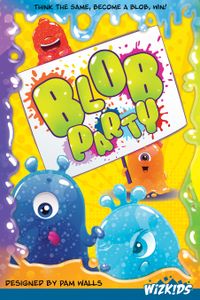
Designer: Pam Walls
Artist: (somebody at Wizkids, I guess?)
Players: 4-8
We go from really complex to an easy party game about words.
Yes, words!
Blob Party is a game where players are trying to all be in synchronicity with the words (or phrases) they choose for the category and clue they are given.

No, not that kind of synchronicity.
Though that is an amazing album.
No, I’m talking about being on the same wavelength.
A category and a word will be displayed and everybody has to write down a word or phrase that will fit it.

Then you compare answers.
Everybody who has the same answer gets to join together in a bigger blob!
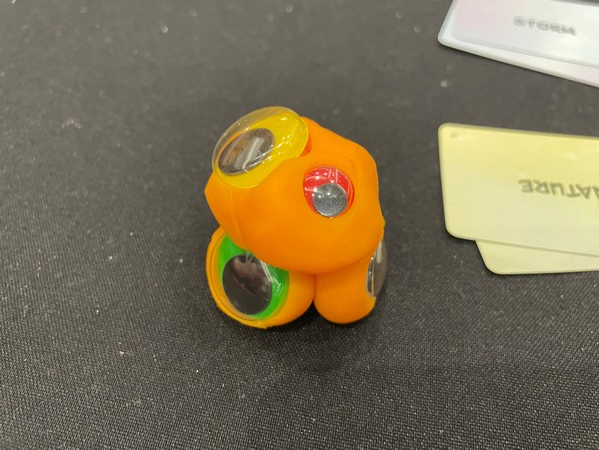
In future rounds, they can compare answers and maybe decide on which one would be best.
If all players are combined in one big blob prior to the 7th round, then everybody wins!
If not…well, you all suck.
As party games go, it’s a fun one.
It’s a word/category game, and I showed my age in our play by answering “9 to 5” to the “Film/Work” category/word while everybody else said “Office Space” (which of course is a better answer). Since I had already combined with others, we were able to say “Office Space” and win!
Anyway, it’s fine. I’m not a huge party game or word game fan, but this is a pretty good example of the genre.
I enjoyed it!
Delta (2023 – Game Brewer) – 1 play

Designer: Franz Couderc
Artist: Nastya Lehn
Players: 2-4
Another Terminal City game!
Delta is a game that takes a bunch of mechanics and then just mashes them all together.

There’s track movement on the gear track, there’s set collection of animal photographs, there’s exploration and kind of area control (not as such, but definitely reminiscent of it).
You’re also going to be collecting cards to put into your deck, but the mechanic involved in this one is that the cards you play in each section will be discarded to that specific discard pile, and one of those discard piles will be put into your hand every round.
I don’t remember the game that I’ve played with a similar mechanic, but I know I have played it!
Each round, you will be playing a card to one of the three sides of the board.

You can only play to a side of the board once, so you are chaining your actions to be able to do stuff.
The items that these cards give you (balloons, money, crystals, flasks) may help you in future actions in the turn, so what order you play can be important.
Also, at the end of the round when all of the actions have been done, players will be taking a card from that each section, the order of which is determined by the stars on their card and the order the action was taken (ties are broken left to right)
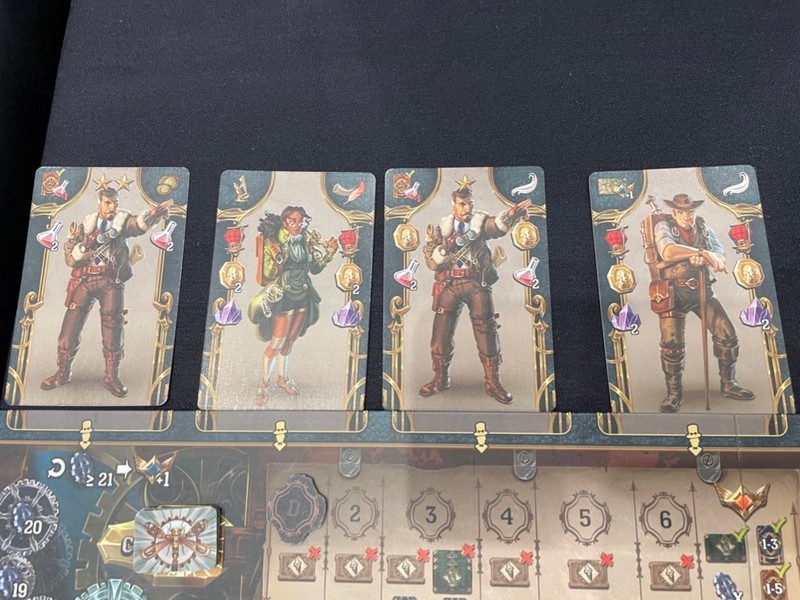
It’s all a mishmash.
One of the main point-getters at the end of the game are animal cards, because you are collecting photos (I think, or hope, they are photos) of a certain animal type, but you also have to move your marker to make sure they are worth more points to you.


If you haven’t moved your marker, it doesn’t matter how many geese you have! You won’t get any points.
The game goes over six rounds, where you are doing all of this stuff each time.
You’re trying to expand in the exploration area, move up the gear track (which also determines turn choice order), and get endgame scoring cards along with moving your animal track up.
It all jumbles together and you have to try and optimize how you are doing one or two things in order to get as many points as possible.
I did enjoy this game, but it didn’t really wow me. I’d have to try it again to see if that’s just a first impression or if it’s just not my type of game.
Rise to Power (2014 – Ape Games) – 1 play

Designers: Allen Chang, Alannah Kearney
Artist: Nick H. Smith
Players: 2-6
Rise to Power is a game that really flew under the radar when it hit in 2014, as I had never heard of it.
(Editor: “Like that’s an indication”)
It’s actually a card tableau-building, city-building game that’s actually kind of interesting.

Players start with a Power Plant along with some PRISM cards (which are basically the energy source, I think?).
You then will take one of the available contracts and place them in your city, adjacent to a part that’s already completed (including the Power Plant, of course).
You will then have to eventually spend enough PRISM of the right colour in order to complete the contract.
If you end up completing the same contract (like Hinterland above) and you have an already built district of the same name, and you meet the requirements, rather than flipping the card, you can place it on top of the already built card, upgrading it.
This will come in handy because, depending on how you’ve built your city, you can only have so many districts built at once.
If you don’t have room on your power grid, you can’t build any more!

The game ends when somebody has completed their 8th district (all other players get one more turn) or if it’s not possible to refill all the available contracts (in which case everybody gets one more turn).
One cool feature of the game is that if you have a contract in your grid, you can actually discard that contract to get the really powerful effect (the Hinterland above lets you draw 5 contracts from the deck and acquire 2 into your grid). However, the contract then goes out on the table, in its completed form and somebody else can just take it if they want without having to spend PRISM to complete it.
Do you really need that effect? Will that district help somebody else?
Who knows?
We had some rules challenges with this one, so I would like to play it again just to see how well it flows when we know what we are doing.
It was fun, but unless it improves after a second play, it’s not something I need to play again.
Challengers! (2022 – Z-Man Games) – 1 play (tournament)

Designers: Johannes Krenner, Markus Slawitscheck
Artist: Jeff Harvey
Players: 1-8 (or with the expansion, up to 16 like we did!)
In a way, Challengers is more an activity than a game, but it’s definitely a fun activity!
It’s a tournament so you do need more than a few players (I’m not sure what the minimum player count is, but we played with the maximum of 8).

You’re going to be playing one game of basically War with powers with each other person in the tournament.
The first player plays a card. If it has a power that’s relevant, it activates. They get the flag.
The next player plays until their combined total of strength is equal to or more than the other players. Then the other player’s card goes to the Bench and you have the flag. The other player flips cards until they have more strength, etc, etc.
However, as I said, some cards have powers.

Some will let you look at your top card.
Some, like the Butler above, will let you remove cards from your Bench.
Why is that important?
The game ends when either a player needs to flip a card from their deck and their deck is empty, or when you need to send a card to your Bench but your bench is full.
The Butler removes two cards from your Bench, making it easier!
Each individual game takes about 5 minutes, if that.
But the tournaments (which really this “game” is a tournament, not just one iteration of the game) can take about an hour, which really works well.
Between matches, you can acquire cards from various decks, that may work better with what you have or just be more powerful in general.
You can also get rid of as many cards from your deck as you want.
You don’t want to get rid of too many, though, or your deck will run out quickly.
But you also don’t want to have too many different types of cards in your deck.
Cards of the same type go to the Bench on top of each other. You’re not taking up another spot on your Bench.
So the game ends when you already have six types of cards on your Bench and you need to place a seventh.
This was fun. We played a 16-player tournament at Terminal City, using the expansion (so 8 of us played base set and 8 of us played expansion) and it was really enjoyable.
I think this is definitely a convention game for me, though. I can’t imagine any of my game days accommodating this game.
But I really enjoyed it!
Of What’s Left (2023 – Gotcha Gotcha Games) – 1 play

Designer: Taylor Reiner
Artist: 別府さい (Sai Beppu)
Players: 3-4
Another Terminal City game, and it’s a game that we didn’t quite get when we played it, until we were halfway through.
It’s a card-shedding game, but you don’t want to shed all of them!

The lead player will play a set of cards (either one card, a pair, a straight of some length, three or four of a kind, etc).
The next player has to play the same thing, but higher value (so if it’s one 7, then they must play one 8 or higher, or a pair of 3s must get a pair of 4s or higher.
If you can’t do that, you pass.
Play goes around until somebody’s out of cards.

The thing is, if you have more than 5 cards left in your hand, you can pass if you don’t want to get rid of your cards.
Once you have 5 or fewer cards, you can’t do that.
When somebody sheds all of their cards, they get 0 points.
The other players get -1 point for each card left in their hand.
However, if they have 5 or fewer cards, they also get the value of their lowest value card left in their hand as positive points.
So if you have one card left and it’s a 10, you get 9 points (10 points minus one point for the card in your hand).
Thus, this is a “shed cards, but not necessarily all of them” kind of game.
It’s actually really interesting!
It was half-way through our game before we realized that it’s not necessarily good to lose all your cards if others have good cards left.
I really enjoyed this one, and would love to play it again with the knowledge of what it’s supposed to be like all the way through the game rather than halfway through.
Sea Salt & Paper (2022 – Pandasaurus Games/Bombyx Games) – 1 play

Designers: Bruno Cathala, Théo Rivière
Artists: Lucien Derainne, Pierre-Yves Gallard
Players: 2-4
Sea Salt & Paper is an interesting card game that I really don’t know how to classify.
There’s a bit of set collection, but the sets are uniquely defined.

During the game, you can play sets down onto the table, but other scoring cards stay in your hand, which means they’re subject to being stolen by another card ability somebody else might play.
Playing a pair of ships, for example, will give you one point but also give you another turn.
On your turn, you’re basically going to be just taking a card from either one of the discard piles or from the top of the deck, and then you can play a pair for an ability if you have them.
Scoring sets, like a mermaid (scoring colours of cards) stay in your hand, though. One of the pairs you can play allows you to steal a random card from somebody’s hand, which can really screw them!

If the deck runs out, then nobody scores, but at some point a player can either say “Stop” (which scores all cards for everybody) or “Last Chance” which is kind of a bet that you’re going to score higher than the other players.
Keep going until somebody hits the points threshold (which depends on the number of players).
This was a fun, very light, but also very quick game that would be wonderful for a lunch time game.
Surfosaurus MAX (2023 – Loosey Goosey Games) – 1 play

Designer: Ikhwan Kwon
Artists: Lisa Goldstein, Matthias Mödl
Players: 2-6
Finally (and maybe this shouldn’t be last, because I can’t really say “last, but not least”) we have another semi-cooperative game where players are trying to make the best poker hand with all the other players.
If you contribute to the hand, then your card that contributed scores!
If somebody else’s card contributes the same way yours did, then it will only score half.
If you didn’t contribute at all, well, it sucks to be you.

Once the endgame condition has been reached, whoever has the most points from cards contributing wins!
So if your white 7 is part of the 5-card run that others have made, you get 6 points!
But if somebody else played the pink 7 card also, then they also contributed. Which means you both get half points (3 instead of 6 in this case).
We had some issues with how to determine exactly how a card contributed, so maybe we scored it wrong?
It’s a fun, very quick, game where you are kind of cooperating (if you don’t make a poker hand, nobody gets points) but you want to cooperate the best.
It’s something I’d play again, but it’s kind of a party game (not really, but a little bit?) so it’s not really in my wheelhouse.
The Vale of Eternity (2023 – Pegasus Spiele/Renegade Game Studios) – 1 play
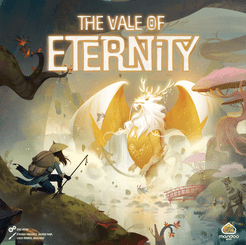
Designer: Eric Hong
Artists: Jiahui Eva Gao, Gautier Maia, Stefano Martinuz, Erica Tormen
Players: 2-4 players
The Vale of Eternity is a card game that I’ve been playing quite a bit on Boardgame Arena but finally got to the table on the last day of March.
It’s a combo-tastic game where you are trying to play cards to your area that will combine with other cards and score you lots of points.

Each round (there are 10 unless somebody breaks 60 points first, ending the game in that round), a number of cards equal to twice the number of players will be put in display.
There are 5 different families of cards.
In turn order and then reverse turn order (is there a name for this mechanism?), players will place their token on one of the available cards, claiming it.

So in rotation in a 3-player game, choice goes Players 1,2,3,3,2,1.
Once every card has been claimed, in player order you will either sell a card (getting stones based on what family it is from, selling the above Eternity card will get you a 6-stone) or Tame it (put it into your hand). You can also use the stones you have to Summon a card from your hand (the cost is in the top left of the card).
There are 1, 3 and 6-value stones available, and you can only hold four total stones at any one time (unless you have a card that lets you store more). So you could have four 6-stones and thus have 24 value!
But you have to use the stones to Summon cards and you don’t get any change. So if you only have a 6-value stone and the card you want to Summon costs 3, you’re out of luck. You have to use the 6.
Of course, you could try and get a 3-value stone some way, but maybe that won’t work!
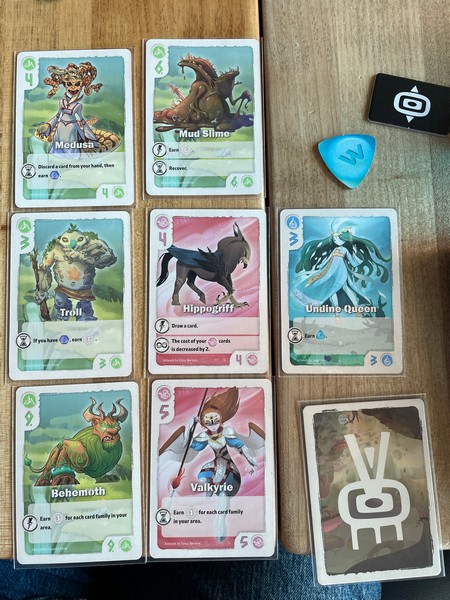
If the card has a lightning symbol, that effect happens immediately.
After all actions have been taken, you do the hourglass symbols of all the cards in your area, in any order you choose.

As soon as somebody reaches 60 points, or the 10th round is over, the game ends!
I did enjoy this game a lot, though I do have to say that I really don’t like snaking scoreboards. They’re way too confusing.
But the game itself is pretty cool, with players trying to form point-generating combinations with the cards that they Summon in their play area.
While I definitely did enjoy it and would love to play it again (and playing it on BGA is really great), I wasn’t as wowed by it as a number of other reviewers have been.
it’s definitely a game I like a lot, but I’m not sure it would be in my Top 50.
Maybe after a few more plays?
There you have it!
All the new to me games I played in March 2024.
What new to you games did you play in March?
Let me know in the comments.
Pingback: March 2024 Gaming – Dude! Take Your Turn!
April has been wild for me, so I’m just now getting time to write … well, anything.
March was pretty active for me for variety, and the FLGS had a garage sale that gave us a few new things to try.
SCOUT – You’re well familiar with this one. It’s gone over reasonably well with my game group, but it’s unfortunately hitting the table most often as a 3P side game rather than a 4-5P feature game. I think it’s been working better at 5.
Backgammon and Terraforming Mars – not actually new to me, but the first time I’ve played either physically… TfM solo mode physically was pretty drab, actually, so I think I’ll stick to digital.
FORT – The theme of this sounded so neat, but the execution hasn’t hit for any of my situations yet. Both times, though, it’s been a learn-and-play which has far exceeded the listed playtime, and I think that’s been a struggle. Maybe when I can get the same people to sit and play it a few times, all the iconography and rules will click better. In related news, this was published by the same crew who did Root, so I suppose that previous sentence shouldn’t be surprising.
Let’s Go To Japan – We’ve played this one five times already and it’s a strong contender for the best 2-player drafting game I’ve ever played. “What if Santa Monica was a drafting game” is a good way to think about it. It’s been very satisfying each time. I think AEG might have a hit (and new franchise) on their hands with this one. The system could be easily tweakable for new locations or mechanics ala “Next Station”.
Tetra Master – The physical version of the card game from Final Fantasy IX. Somehow, this got printed in Germany in the wake of the game’s release – a publisher contacted the guy who wrote a game mechanics guide for GameFAQs and asked him to help create a German physical version. My wife is a huge FF9 fan, and had been watching copies like a hawk for a while. Finally she decided to bite on one. We played it a few times, and it was honestly more enjoyable than it was in FFIX itself; possibly the limited card pool helped balance it a bit.
LikeLiked by 1 person
I really want to play Let’s Go to Japan. It looks pretty cool. And totally agree about Scout and number of players, as you know.
I have Fort but it also hasn’t gone down as well as I had hoped with my friends. Hopefully we’ll try it again
LikeLike